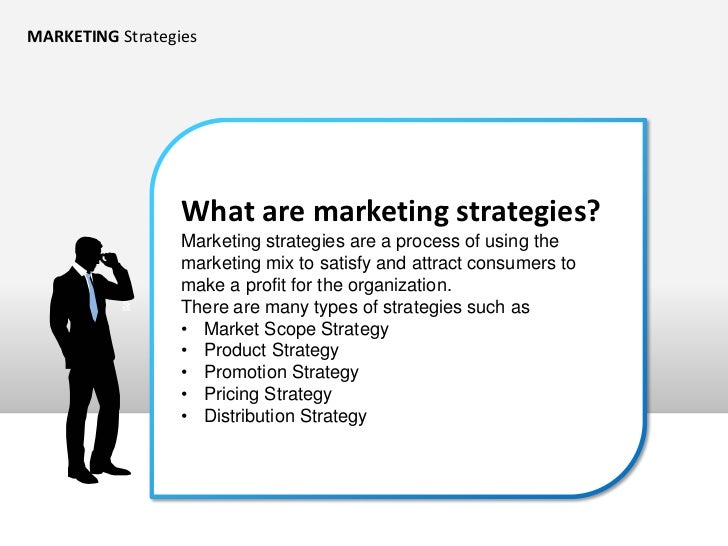
Image source: https://image.slidesharecdn.com/marketingstrategies-120228174106-phpapp01/95/marketing-strategies-2-728.jpg?cb=1330451074
A marketing strategy is a process that can allow an organization to concentrate its limited resources on the greatest opportunities to increase sales and achieve a sustainable competitive advantage. A marketing strategy should be centered around the key concept that customer satisfaction is the main goal.
A marketing strategy is most effective when it is an integral component of corporate strategy, defining how the organization will successfully engage customers, prospects, and competitors in the market arena. corporate strategies, corporate missions, and corporate goals. As the customer constitutes the source of a company's revenue, marketing strategy is closely linked with sales. A key component of marketing strategy is often to keep marketing in line with a company's overarching mission statement.
A marketing strategy can serve as the foundation of a marketing plan. A marketing plan contains a set of specific actions required to successfully implement a marketing strategy. For example: "Use a low cost product to attract consumers. Once our organization, via our low cost product, has established a relationship with consumers, our organization will sell additional, higher-margin products and services that enhance the consumer's interaction with the low-cost product or service."
A strategy consists of a well thought out series of tactics to make a marketing plan more effective. Marketing strategies serve as the fundamental underpinning of marketing plans designed to fill market needs and reach marketing objectives. Plans and objectives are generally tested for measurable results.
A marketing strategy often integrates an organization's marketing goals, policies, and action sequences (tactics) into a cohesive whole. Similarly, the various strands of the strategy , which might include advertising, channel marketing, internet marketing, promotion and public relations can be orchestrated. Many companies cascade a strategy throughout an organization, by creating strategy tactics that then become strategy goals for the next level or group. Each one group is expected to take that strategy goal and develop a set of tactics to achieve that goal. This is why it is important to make each strategy goal measurable.
Wikipedia, the free encyclopedia 2001-2006 Wikipedia Contributors (Disclaimer)
This article is licensed under the GNU Free Documentation License.
Author's Bio:
This definition is part of a series that covers the topic of Marketing Strategy. The Official Guide to Marketing Strategy is Paul Keetch. From a business perspective, Paul brings more than six years of direct-response information marketing experience to the table, with a focus on internet and new media marketing. A lifelong entrepreneur, Paul started his first business at the ripe young age of 13, selling personalized gifts door-to-door as a Regal distributor and has never looked back. He has owned several successful solopreneur businesses including Brokenfeet Design & Consulting and Atlas Avenue Artist Management.
Additional Resources on Marketing Strategy can be found at:
Website Directory for Marketing Strategy
Articles on Marketing Strategy
Products for Marketing Strategy
Discussion Board
Paul Keetch, the Official Guide to Marketing Strategy
